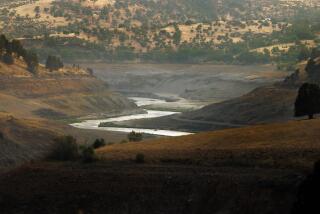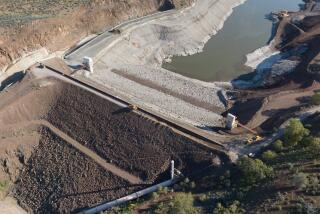The false promise of Hoover Dam
The most striking sight greeting visitors to the Colorado River gorge known as Black Canyon used to be the great wedge of alabaster concrete spanning the canyon wall to wall. But in recent years Hoover Dam, that enduring symbol of mankind’s ingenuity, has been upstaged by another sight signifying nature’s power to resist even the most determined effort to bring it under control: a broad white band stretching along the edge of Lake Mead like a bathtub ring, marking how far the reservoir has fallen below its maximum level.
The nearly decade-long drought in the Colorado River Basin, which has lowered Lake Mead by about 120 feet from its high-water mark, reminds us that the promises made for Hoover Dam were always unrealistic. Delegates from the seven state capitals who met in 1922 to apportion the river’s bounty (under the supervision of then-Commerce Secretary Herbert Hoover) were led to believe that the river, once dammed, would provide all the water their states could conceivably need to fulfill their dreams of irrigation, industrial development and urban growth.
To the federal officials anxious to get the dam project approved, this was a necessary subterfuge, for without it the states would never reach agreement and the dam would not be built. But today we must confront the consequences of that founding fiction. Hoover Dam truly made the West, but it has also confined it in the straitjacket of an ever-intensifying water shortage.
Promises based on the seemingly magical power of new technologies are almost always excessive (witness the tragedy in the Gulf of Mexico). This year, as we celebrate the 75th anniversary of President Franklin D. Roosevelt’s dedication of “the greatest dam in the world” on September 30, 1935, we should also recognize the dam’s equivocal legacy to the West, and to the nation.
Connoisseurs of irony will note that on that day, under a blistering sun and before 10,000 spectators and 20 million radio listeners, FDR claimed as a symbol of the New Deal a public work conceived, designed and launched by his Republican predecessors.
Indeed, during the 1932 presidential campaign, candidate Roosevelt had savagely attacked Hoover, his GOP opponent, for excessive deficit spending on projects like the dam. Once ensconced in the White House, however, he quickly came to appreciate the totemic power of great public works and their effectiveness at representing the benefits that could be bestowed on the citizens by a visionary administration.
In his dedication speech Roosevelt proclaimed that the federal government and the seven states of the Colorado River Basin had jointly ensured that millions of current and future residents in the West would enjoy “a just, safe and permanent system of water rights.” He promised an end to the river’s ancient cycle of drought and floods and a bountiful irrigation supply. He called the dam “a splendid symbol” that had turned the unruly Colorado into “a great national possession.”
The nation took him at his word. Since that dedication year, the population of California and the six other states of the basin has swelled by some 45 million people. Much of this growth has been fueled by the dam and its precious bounties of water and electrical power.
The promise of abundant water and power took the brakes off the growth of Los Angeles, San Diego and many other western cities; it encouraged farmers to complacently plant the most water-thirsty crops; and it gave us city dwellers the impression that we can water our lawns every day without worrying about waste and runoff.
Yet the world Hoover Dam made is now facing the era of limits. For decades California was able to use Colorado River water formally apportioned to Arizona and Nevada, because those states weren’t developed enough to use their full allocations. That condition ended in the mid-1990s, at which point California had to give up nearly 20% of its Colorado River supply.
Thus far we’ve managed a “soft landing” from that shock by crafting intricate reallocations of water among the state’s agricultural, urban and ecological interests. But the balancing act is only getting harder, as a long drought shrinks our water-supply cushion and population growth continues almost unabated. Up to now, solutions to our water needs have been worked out in a crisis atmosphere. In the future, they’ll take place against a political background too.
In the Central Valley, farmers are already marching to demand the construction of more dams to provide more water for irrigation, as if one can just create abundance out of thin air. Environmentalists’ efforts to discharge water from reservoirs to preserve riparian and marine habitats draw the ridicule of conservative television pundits. Private companies have moved into the water business, figuring that where there’s scarcity there are profits.
There isn’t enough water in the Colorado to serve all the demands we place on the river, and there never was. This was evident to some people, like the great Western explorer John Wesley Powell, who at an irrigation congress in 1893 announced, “Gentlemen, you are piling up a heritage of conflict and litigation over water rights, for there is not sufficient water to supply the land.”
Powell was driven from the hall by a chorus of boos and catcalls. But time has proved him right. It was thought that Hoover Dam would put an end to 50 years of conflict over the water of the Colorado. It has not. We still delude ourselves into thinking that it will; only a few years ago, in 2003, then-Interior Secretary Gale Norton came out to the dam to sign 24 agreements transferring water rights among various claimants — Indian tribes, irrigation districts, Western cities, the government of Mexico. And she proclaimed, “With these agreements, conflict on the river is stilled.”
The truth is that conflict on the river will never be stilled, because there will always be more demand for the water than there is water.
We should not regret the building of Hoover Dam, which Roosevelt hailed three-quarters of a century ago as a “great achievement of American resourcefulness, skill and determination.” It was a bold enterprise for a nation grappling with doubts about its place in the world at a time of crisis. Dealing with the problems of resources and growth bequeathed us in part by that remarkable Depression-era effort will require every bit as much boldness and resourcefulness, or more.
Times business columnist Michael Hiltzik is the author of “Colossus: Hoover Dam and the Making of the American Century,” just published by Simon & Schuster.
More to Read
Sign up for Essential California
The most important California stories and recommendations in your inbox every morning.
You may occasionally receive promotional content from the Los Angeles Times.











